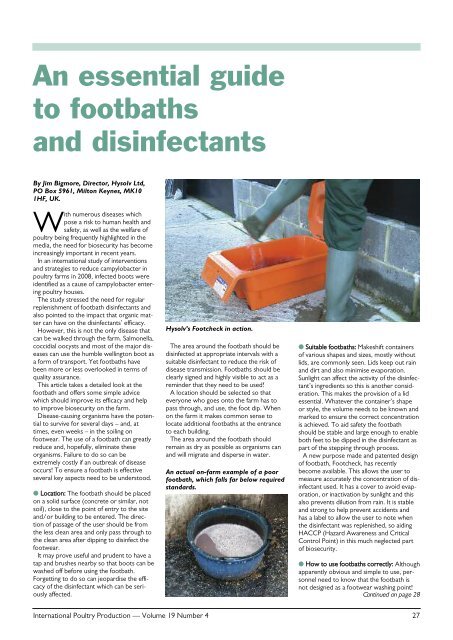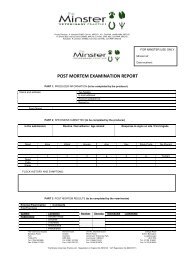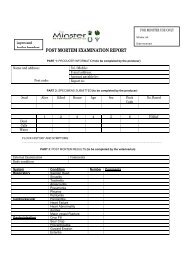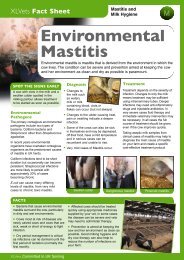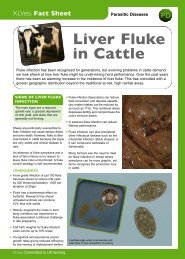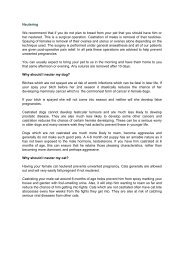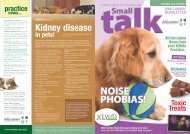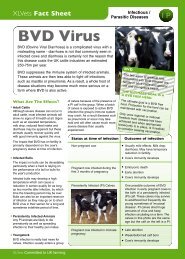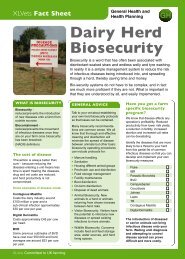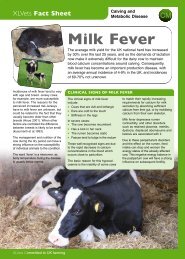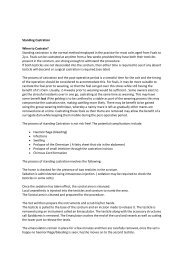Essential Guide to Footbaths and Disinfectants - Hysolv Footcheck
Essential Guide to Footbaths and Disinfectants - Hysolv Footcheck
Essential Guide to Footbaths and Disinfectants - Hysolv Footcheck
You also want an ePaper? Increase the reach of your titles
YUMPU automatically turns print PDFs into web optimized ePapers that Google loves.
An essential guide<br />
<strong>to</strong> footbaths<br />
<strong>and</strong> disinfectants<br />
By Jim Bigmore, Direc<strong>to</strong>r, <strong>Hysolv</strong> Ltd,<br />
PO Box 5961, Mil<strong>to</strong>n Keynes, MK10<br />
1HF, UK.<br />
With numerous diseases which<br />
pose a risk <strong>to</strong> human health <strong>and</strong><br />
safety, as well as the welfare of<br />
poultry being frequently highlighted in the<br />
media, the need for biosecurity has become<br />
increasingly important in recent years.<br />
In an international study of interventions<br />
<strong>and</strong> strategies <strong>to</strong> reduce campylobacter in<br />
poultry farms in 2008, infected boots were<br />
identified as a cause of campylobacter entering<br />
poultry houses.<br />
The study stressed the need for regular<br />
replenishment of footbath disinfectants <strong>and</strong><br />
also pointed <strong>to</strong> the impact that organic matter<br />
can have on the disinfectants’ efficacy.<br />
However, this is not the only disease that<br />
can be walked through the farm. Salmonella,<br />
coccidial oocysts <strong>and</strong> most of the major diseases<br />
can use the humble welling<strong>to</strong>n boot as<br />
a form of transport. Yet footbaths have<br />
been more or less overlooked in terms of<br />
quality assurance.<br />
This article takes a detailed look at the<br />
footbath <strong>and</strong> offers some simple advice<br />
which should improve its efficacy <strong>and</strong> help<br />
<strong>to</strong> improve biosecurity on the farm.<br />
Disease-causing organisms have the potential<br />
<strong>to</strong> survive for several days – <strong>and</strong>, at<br />
times, even weeks – in the soiling on<br />
footwear. The use of a footbath can greatly<br />
reduce <strong>and</strong>, hopefully, eliminate these<br />
organisms. Failure <strong>to</strong> do so can be<br />
extremely costly if an outbreak of disease<br />
occurs! To ensure a footbath is effective<br />
several key aspects need <strong>to</strong> be unders<strong>to</strong>od.<br />
● Location: The footbath should be placed<br />
on a solid surface (concrete or similar, not<br />
soil), close <strong>to</strong> the point of entry <strong>to</strong> the site<br />
<strong>and</strong>/or building <strong>to</strong> be entered. The direction<br />
of passage of the user should be from<br />
the less clean area <strong>and</strong> only pass through <strong>to</strong><br />
the clean area after dipping <strong>to</strong> disinfect the<br />
footwear.<br />
It may prove useful <strong>and</strong> prudent <strong>to</strong> have a<br />
tap <strong>and</strong> brushes nearby so that boots can be<br />
washed off before using the footbath.<br />
Forgetting <strong>to</strong> do so can jeopardise the efficacy<br />
of the disinfectant which can be seriously<br />
affected.<br />
<strong>Hysolv</strong>’s <strong>Footcheck</strong> in action.<br />
The area around the footbath should be<br />
disinfected at appropriate intervals with a<br />
suitable disinfectant <strong>to</strong> reduce the risk of<br />
disease transmission. <strong>Footbaths</strong> should be<br />
clearly signed <strong>and</strong> highly visible <strong>to</strong> act as a<br />
reminder that they need <strong>to</strong> be used!<br />
A location should be selected so that<br />
everyone who goes on<strong>to</strong> the farm has <strong>to</strong><br />
pass through, <strong>and</strong> use, the foot dip. When<br />
on the farm it makes common sense <strong>to</strong><br />
locate additional footbaths at the entrance<br />
<strong>to</strong> each building.<br />
The area around the footbath should<br />
remain as dry as possible as organisms can<br />
<strong>and</strong> will migrate <strong>and</strong> disperse in water.<br />
An actual on-farm example of a poor<br />
footbath, which falls far below required<br />
st<strong>and</strong>ards.<br />
● Suitable footbaths: Makeshift containers<br />
of various shapes <strong>and</strong> sizes, mostly without<br />
lids, are commonly seen. Lids keep out rain<br />
<strong>and</strong> dirt <strong>and</strong> also minimise evaporation.<br />
Sunlight can affect the activity of the disinfectant’s<br />
ingredients so this is another consideration.<br />
This makes the provision of a lid<br />
essential. Whatever the container’s shape<br />
or style, the volume needs <strong>to</strong> be known <strong>and</strong><br />
marked <strong>to</strong> ensure the correct concentration<br />
is achieved. To aid safety the footbath<br />
should be stable <strong>and</strong> large enough <strong>to</strong> enable<br />
both feet <strong>to</strong> be dipped in the disinfectant as<br />
part of the stepping through process.<br />
A new purpose made <strong>and</strong> patented design<br />
of footbath, <strong>Footcheck</strong>, has recently<br />
become available. This allows the user <strong>to</strong><br />
measure accurately the concentration of disinfectant<br />
used. It has a cover <strong>to</strong> avoid evaporation,<br />
or inactivation by sunlight <strong>and</strong> this<br />
also prevents dilution from rain. It is stable<br />
<strong>and</strong> strong <strong>to</strong> help prevent accidents <strong>and</strong><br />
has a label <strong>to</strong> allow the user <strong>to</strong> note when<br />
the disinfectant was replenished, so aiding<br />
HACCP (Hazard Awareness <strong>and</strong> Critical<br />
Control Point) in this much neglected part<br />
of biosecurity.<br />
● How <strong>to</strong> use footbaths correctly: Although<br />
apparently obvious <strong>and</strong> simple <strong>to</strong> use, personnel<br />
need <strong>to</strong> know that the footbath is<br />
not designed as a footwear washing point!<br />
Continued on page 28<br />
International Poultry Production — Volume 19 Number 4 27
Continued from page 27<br />
Boots should first be cleaned <strong>and</strong> then disinfected<br />
– the disinfectant needs <strong>to</strong> come in<strong>to</strong><br />
contact with the organisms <strong>to</strong> kill them. Best<br />
practice would dictate that the idea is <strong>to</strong><br />
create a ‘barrier’, with passage of footwear<br />
from the potentially contaminated area<br />
through <strong>to</strong> a cleaner area, thus preventing<br />
the transfer of organisms <strong>and</strong> reduce the<br />
risk of disease.<br />
● Management/auditing: Staff <strong>and</strong> visi<strong>to</strong>rs<br />
should be made aware that use of the footbath<br />
is obliga<strong>to</strong>ry <strong>and</strong> not optional, as is the<br />
need <strong>to</strong> record what disinfectant is being<br />
used, at what concentration <strong>and</strong> how frequently<br />
the contents need <strong>to</strong> be renewed,<br />
<strong>and</strong> who was responsible for this process.<br />
Most quality assurance schemes include a<br />
record keeping system for audit purposes.<br />
It makes sense <strong>to</strong> wash the footbath inside<br />
<strong>and</strong> out each time the contents are replenished<br />
<strong>to</strong> remove the dirt <strong>and</strong> the sediment<br />
which accumulates.<br />
If a measuring container is required this<br />
should be accurate <strong>and</strong> clearly marked. Care<br />
should always be taken when dispensing<br />
concentrated chemicals. The manufacturer’s<br />
recommendations for protective precautions<br />
should always be adhered <strong>to</strong>.<br />
<strong>Footcheck</strong> has integral chambers <strong>to</strong> measure<br />
disinfectant concentrate directly from<br />
the dispensing container, improving safety<br />
<strong>and</strong> avoiding ad-hoc guesswork as <strong>to</strong> the<br />
amount of concentrate needed <strong>to</strong> ensure<br />
the right dilution is applied.<br />
St<strong>and</strong>ard Operating Procedures (SOPs)<br />
should be in place <strong>and</strong> staff need <strong>to</strong> be made<br />
aware that these should be adhered <strong>to</strong>. As<br />
with most things in life if procedures are<br />
simple <strong>and</strong> easy <strong>to</strong> follow the likelihood of<br />
compliance is increased significantly.<br />
Choosing a disinfectant<br />
This is a whole area in itself <strong>and</strong> requires<br />
some background knowledge <strong>to</strong> make an<br />
appropriate choice <strong>and</strong> minimise risk of the<br />
biosecurity being compromised.<br />
Not all disinfectants are suitable for all purposes.<br />
Table 1 provides a general guide <strong>and</strong><br />
there may be specific disinfectants that differ<br />
in some details.<br />
Table 1 illustrates the range of approved<br />
rates under the German Veterinary Industry<br />
(DVG) scheme. The German test methodology<br />
is useful as a model for footbaths as it<br />
requires higher levels of organic matter as<br />
part of their test criteria <strong>and</strong> therefore mimics<br />
conditions in which disinfectants will be<br />
expected <strong>to</strong> work when used in footbaths.<br />
● Glutaraldehyde + formaldehyde disinfectants.<br />
These are the least sensitive <strong>to</strong> the<br />
presence of organic matter <strong>and</strong> are ideal for<br />
use in footbaths, providing the outside temperature<br />
stays above 5°C. A 1% solution in<br />
a footbath should be sufficient <strong>to</strong> protect<br />
poultry houses against all viruses, bacteria<br />
<strong>and</strong> fungi.<br />
● Glutaraldehyde + quaternary ammonium<br />
salts. The combination of ‘gluts’ <strong>and</strong> ‘quats’<br />
as a disinfectant is quite common. Although<br />
improving performance at lower temperatures,<br />
efficacy against non-enveloped viruses<br />
is sacrificed (see quaternary ammonium<br />
salts). There are 25 glut/quat disinfectants<br />
approved under the DVG test criteria <strong>and</strong><br />
all would require a footbath concentration<br />
of 2-6% <strong>to</strong> be effective against all viruses,<br />
bacteria <strong>and</strong> fungi.<br />
● Chlorocresols. This type of modern phenol<br />
works well as a footbath disinfectant <strong>and</strong><br />
can also be used <strong>to</strong> help prevent coccidial<br />
oocysts being walked in<strong>to</strong> cleaned poultry<br />
housing. These disinfectants have <strong>to</strong> be used<br />
at relatively high concentrations of 2-4%<br />
against viruses but are extremely effective<br />
against bacteria at 0.5% even in the presence<br />
of high levels of organic matter (test<br />
method EN 14349). Some farms have used<br />
a chlorocresol disinfectant in the footbath of<br />
pullet housing <strong>to</strong> prevent field strains of coccidial<br />
oocyst being walked in <strong>and</strong> interfering<br />
with coccidiosis vaccination.<br />
● Oxidising disinfectants. This group of disinfectants<br />
is sensitive <strong>to</strong> the presence of<br />
organic matter <strong>and</strong> generally has <strong>to</strong> be used<br />
28 International Poultry Production — Volume 19 Number 4
Disinfectant Typical concentration of disinfectant required in a Sensitivity<br />
type<br />
footbath <strong>to</strong> eliminate different micro-organisms<br />
Non-enveloped Enveloped Bacteria Fungi Coccidial Organic Temp.<br />
viruses viruses oocysts matter


